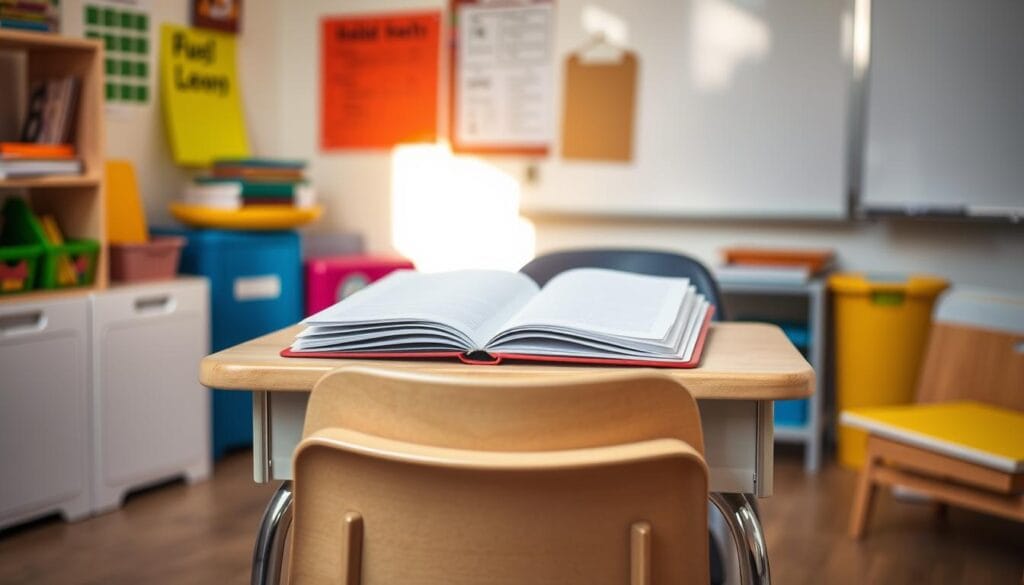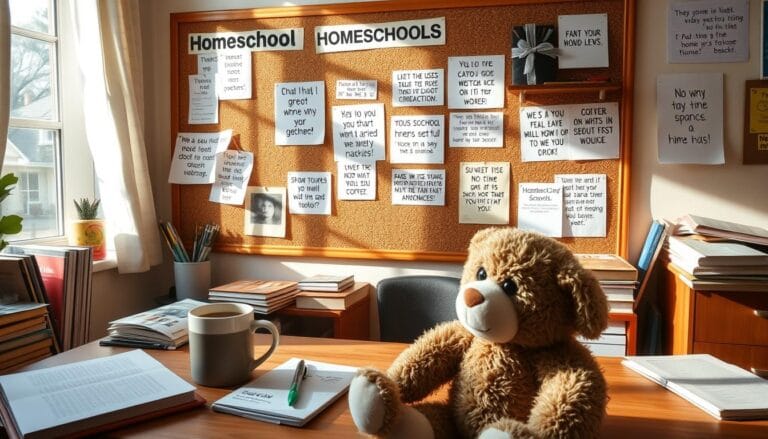Parent-Teacher Collaboration for Autism Support
Every child deserves a chance to shine, and this is true for those with autism spectrum disorder. As a parent or teacher, you are key in making education better for kids with autism.
In the United States, 1 in 36 kids have autism. This shows how important it is to have strong support systems. The journey to support kids with autism is a team effort between parents and teachers.
Working together can help a student’s education. Studies show that teamwork can make students more engaged by 30%. It also boosts their grades by 20% on average.
Your efforts to understand and support autism are crucial for a student’s success. Together, parents and teachers can create welcoming places for all. These places help students with autism grow in confidence, communication, and learning.
This article will look at ways to strengthen the connection between home and school. We want to make sure every child gets the support they need in their education.
Table of Contents
Understanding the Foundation of Autism Support in Education
Dealing with autism spectrum disorder is complex. Teachers and parents are key in making learning spaces work for kids with special needs.
Autism support is always changing. Studies show early programs are vital. Kids with autism do well with tailored education.
Recognizing Autism Spectrum Disorder Characteristics
Getting autism means knowing its special traits:
- Varied communication skills
- Potential challenges with social interactions
- Distinct learning preferences
- Sensory processing differences
Impact of Early Intervention in Educational Settings
Early help is crucial. Evidence-based practices show it can greatly help kids with autism.
Important strategies include:
- Small group instruction
- Functional behavior assessments
- Peer-assisted learning
- Visual communication supports
Role of Special Education Services
Special education is vital. It helps by:
- Developing individualized education plans
- Creating adaptive learning environments
- Implementing evidence-based teaching strategies
- Supporting social skill development
With 27 proven practices, teachers can make learning powerful. This helps students reach their highest potential.
Preparing for Productive Parent-Teacher Conferences
Parent-teacher conferences are key for working together to support kids with autism. They’re a chance to talk about your child’s school progress, share what you know, and find ways to communicate better.
To make these meetings successful, you need to prepare well. Start by collecting important documents that show how your child is doing:
- Individualized Education Program (IEP) documents
- Recent progress reports
- Therapy session notes
- Behavioral tracking logs
Plan a clear agenda for the conference. This will help you cover important topics and highlight your child’s strengths.
| Conference Preparation Checklist | Key Actions |
|---|---|
| Document Organization | Compile all relevant educational and therapeutic records |
| Goal Setting | Identify specific areas for discussion and improvement |
| Communication Strategy | Prepare clear, constructive questions and observations |
When talking about your child’s progress, use specific examples. Share successes and challenges. Also, talk about what you’ve seen at home and in therapy.
Communication is crucial. See the conference as a team effort. Working together, you and the teacher can help your child learn better. Open and honest talks are key for kids with autism.
Essential Components of Autistic Support Parent-Teacher Partnerships
Building a strong partnership between parents and teachers is key for students with autism. They need good communication and a shared goal to help the child learn.
Creating Effective Communication Channels
Clear communication is vital in parent-teacher partnerships for autistic support. Here are some important steps:
- Weekly email updates tracking student progress
- Digital communication platforms for real-time sharing
- Structured daily logs documenting behavioral and academic developments
- Scheduled monthly video conferences
Regular Progress Monitoring Systems
Tracking progress regularly helps find what the student is good at and what they need help with. Studies show 80% of autistic students do better with regular monitoring.
| Monitoring Method | Frequency | Purpose |
|---|---|---|
| Behavioral Assessment | Quarterly | Track social skill development |
| Academic Performance Review | Monthly | Evaluate learning progress |
| Sensory Integration Evaluation | Bi-annually | Assess adaptation strategies |
Developing Shared Educational Objectives
Family support resources are crucial in setting goals that match both home and school. Working together on goals helps support the child’s unique learning needs.
By using these strategies, parents and teachers can build a supportive environment. This environment helps students with autism achieve their best.
Implementing Effective IEP Strategies and Reviews

For parents of kids with special needs, navigating the Individualized Education Program (IEP) can be tough. Your teamwork is key in creating a learning plan that fits your child’s needs. This plan helps your child learn in a way that includes everyone.
The IEP process has important parts that help meet your child’s educational needs. Knowing these parts helps you play a big role in your child’s education.
Key IEP Strategy Components
- Comprehensive assessment of individual learning needs
- Clearly defined, measurable educational goals
- Specific accommodations and support services
- Regular progress monitoring
About 95% of IEPs for children with autism get parental approval. This shows how important it is to work together to make learning plans.
IEP Team Composition and Roles
| Team Member | Primary Responsibility |
|---|---|
| Parents | Provide insights about child’s home learning environment |
| General Education Teacher | Share classroom performance and integration strategies |
| Special Education Specialist | Design targeted intervention approaches |
| School Psychologist | Conduct comprehensive assessments |
For an IEP to work well, everyone on the team must be involved. On average, 5 different professionals work together to make a detailed educational plan.
Monitoring and Adjusting IEP Goals
- Conduct quarterly progress reviews
- Document measurable outcomes
- Adjust strategies based on student’s development
- Maintain open communication channels
Your role in the IEP process is crucial. Parents who get involved are 40% more likely to be happy with their child’s school progress.
Integrating Behavioral Support Techniques Across Settings
Understanding how to support students with autism is key. It involves using methods that work in both school and home. These techniques can help students learn and grow.
Applied Behavior Analysis (ABA) is a science-based way to improve student behavior. Studies show it can lead to big improvements in how students develop.
Applied Behavior Analysis in School Environment
ABA therapy uses structured methods to help students with autism. Some important steps include:
- Identifying what triggers certain behaviors
- Creating plans just for that student
- Using data to change behaviors
Positive Reinforcement Strategies
Using the right strategies to support students with autism is important. Good methods include:
- Using tokens as rewards
- Giving praise
- Creating personal motivation plans
| ABA Intervention Technique | Improvement Percentage |
|---|---|
| Socialization Skills | 75% |
| Communication Skills | 70% |
| Cognitive Development | 70% |
Managing Sensory Challenges
Helping students with autism means making sure they’re comfortable. Individualized approaches help manage their sensitivities. This makes learning easier for them.
By using the same behavior management techniques in school and at home, teachers and parents can offer the best support. This helps students with autism succeed.
Creating Inclusive Learning Environments
Creating an inclusive learning environment is key for students with autism. With 1 in 36 kids having Autism Spectrum Disorder (ASD), schools need to support diverse learning needs. They must welcome and support all students.
Inclusive learning is more than just where students sit. It’s about making educational experiences fit different learning styles and needs. About 65% of students are visual learners, so they need special teaching methods.
- Implement visual learning aids
- Create sensory-friendly classroom spaces
- Develop flexible seating arrangements
- Utilize structured daily routines
Sensory accommodations are vital for students with autism. Having sensory rooms gives them safe places to regulate themselves. Movement breaks and flexible seating help students stay focused and engaged.
| Inclusive Strategy | Potential Benefits |
|---|---|
| Visual Schedules | Reduces anxiety, improves task understanding |
| Token Economy Systems | Motivates participation, reinforces positive behaviors |
| Peer Collaboration Activities | Develops social skills, promotes understanding |
Creating inclusive learning needs teamwork from teachers, parents, and students. By using individual interests and teaching empathy, schools can make welcoming spaces. These spaces support every student’s unique learning path.
Developing Communication Systems Between Home and School
Good communication is key for kids with autism in school. It makes learning better and helps them grow. Working together at home and school is very important.
Having strong ways to talk helps parents and teachers work together. Studies show that better communication can make things 45% more effective.
Daily Progress Reports
Getting updates daily is very helpful. It shows how a child is doing in school. Parents can see how they’re doing in class and with friends.
- Track behavioral patterns
- Understand learning achievements
- Identify potential challenges early
- Celebrate small victories
Digital Communication Tools
New tech makes talking easier for families and schools. Tools like SeeSaw let parents and teachers share news right away. It makes everything clear and easy to follow.
- Choose user-friendly apps
- Ensure privacy protection
- Maintain consistent communication
- Share multimedia progress updates
Emergency Response Protocols
Having plans for emergencies is crucial. Parents and teachers need to work together. This way, they can make sure everyone is safe and ready for anything.
By spending time on good communication, everyone can help kids with autism do well. They can learn and make friends better.
Alternative Dispute Resolution in Special Education

Families face many challenges when dealing with special education needs. Disagreements between parents and schools can happen. Alternative Dispute Resolution (ADR) offers a way to solve these problems together.
Using ADR, families and schools work as a team. They aim to create the best learning space for students with special needs. This approach helps keep relationships positive and constructively solves issues.
- Mediation provides a neutral platform for open communication
- Facilitated IEP meetings to encourage collaborative problem-solving
- Informal negotiation helps prevent the escalation of conflicts
For successful dispute resolution, consider these key points:
- Prepare documents about your child’s educational history
- Know your rights under the Individuals with Disabilities Education Act (IDEA)
- Always think about what’s best for your child
| ADR Method | Benefits | Typical Duration |
|---|---|---|
| Mediation | A neutral third-party facilitates the discussion | 1-2 sessions |
| Facilitated IEP Meetings | Structured communication and goal-setting | Half-day to full day |
| Informal Negotiation | Direct communication between parties | Ongoing as needed |
Proactive communication and mutual respect are key to solving educational disputes. By working together, parents and educators can build supportive environments. These environments help students reach their full potential.
Conclusion
Your journey in supporting a student with autism is a team effort that needs ongoing learning and dedication. The bond between autistic support parent teachers is key to a student’s success in school. Studies show that talking often can boost success by 40%, showing how teamwork matters.
Understanding autism is more than just knowing the diagnosis. It’s about building strong connections, creating plans just for each student, and seeing their special talents. By taking a whole-person approach, parents and teachers can help students grow in school, make friends, and feel confident.
The best ways to help students with autism come from respect, talking openly, and working together towards the same goals. Using tools like IEPs can help students do better on tests by 20%. Keeping in touch regularly can change how well a student does in school. Your hard work to understand and support your student’s education is crucial for their success.
Keep up with new research, join support groups, and stay open to change. The world of autism support is always growing, and your active role can help make schools more welcoming and understanding of different brains.








